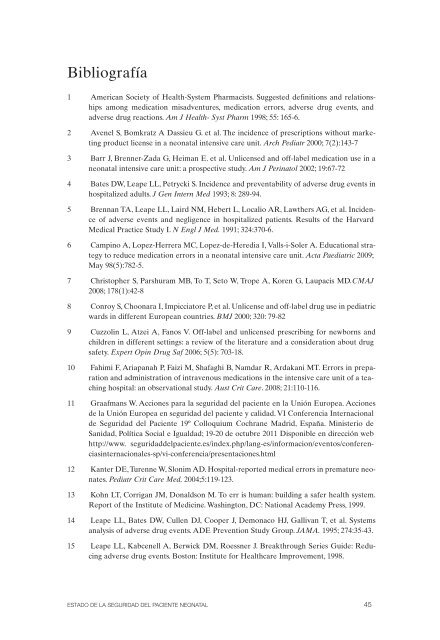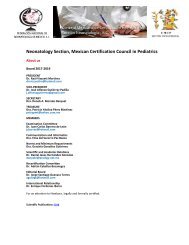Paciente Neonatal
5mxkEBc5Z
5mxkEBc5Z
Create successful ePaper yourself
Turn your PDF publications into a flip-book with our unique Google optimized e-Paper software.
Bibliografía<br />
1 American Society of Health-System Pharmacists. Suggested definitions and relationships<br />
among medication misadventures, medication errors, adverse drug events, and<br />
adverse drug reactions. Am J Health- Syst Pharm 1998; 55: 165-6.<br />
2 Avenel S, Bomkratz A Dassieu G. et al. The incidence of prescriptions without marketing<br />
product license in a neonatal intensive care unit. Arch Pediatr 2000; 7(2):143-7<br />
3 Barr J, Brenner-Zada G, Heiman E. et al. Unlicensed and off-label medication use in a<br />
neonatal intensive care unit: a prospective study. Am J Perinatol 2002; 19:67-72<br />
4 Bates DW, Leape LL, Petrycki S. Incidence and preventability of adverse drug events in<br />
hospitalized adults. J Gen Intern Med 1993; 8: 289-94.<br />
5 Brennan TA, Leape LL, Laird NM, Hebert L, Localio AR, Lawthers AG, et al. Incidence<br />
of adverse events and negligence in hospitalized patients. Results of the Harvard<br />
Medical Practice Study I. N Engl J Med. 1991; 324:370-6.<br />
6 Campino A, Lopez-Herrera MC, Lopez-de-Heredia I, Valls-i-Soler A. Educational strategy<br />
to reduce medication errors in a neonatal intensive care unit. Acta Paediatric 2009;<br />
May 98(5):782-5.<br />
7 Christopher S, Parshuram MB, To T, Seto W, Trope A, Koren G, Laupacis MD. CMAJ<br />
2008; 178(1):42-8<br />
8 Conroy S, Choonara I, Impicciatore P, et al. Unlicense and off-label drug use in pediatric<br />
wards in different European countries. BMJ 2000; 320: 79-82<br />
9 Cuzzolin L, Atzei A, Fanos V. Off-label and unlicensed prescribing for newborns and<br />
children in different settings: a review of the literature and a consideration about drug<br />
safety. Expert Opin Drug Saf 2006; 5(5): 703-18.<br />
10 Fahimi F, Ariapanah P, Faizi M, Shafaghi B, Namdar R, Ardakani MT. Errors in preparation<br />
and administration of intravenous medications in the intensive care unit of a teaching<br />
hospital: an observational study. Aust Crit Care. 2008; 21:110-116.<br />
11 Graafmans W. Acciones para la seguridad del paciente en la Unión Europea. Acciones<br />
de la Unión Europea en seguridad del paciente y calidad. VI Conferencia Internacional<br />
de Seguridad del <strong>Paciente</strong> 19º Colloquium Cochrane Madrid, España. Ministerio de<br />
Sanidad, Política Social e Igualdad; 19-20 de octubre 2011 Disponible en dirección web<br />
http://www. seguridaddelpaciente.es/index.php/lang-es/informacion/eventos/conferenciasinternacionales-sp/vi-conferencia/presentaciones.html<br />
12 Kanter DE,Turenne W, Slonim AD. Hospital-reported medical errors in premature neonates.<br />
Pediatr Crit Care Med. 2004;5:119-123.<br />
13 Kohn LT, Corrigan JM, Donaldson M. To err is human: building a safer health system.<br />
Report of the Institute of Medicine. Washington, DC: National Academy Press, 1999.<br />
14 Leape LL, Bates DW, Cullen DJ, Cooper J, Demonaco HJ, Gallivan T, et al. Systems<br />
analysis of adverse drug events. ADE Prevention Study Group. JAMA. 1995; 274:35-43.<br />
15 Leape LL, Kabcenell A, Berwick DM, Roessner J. Breakthrough Series Guide: Reducing<br />
adverse drug events. Boston: Institute for Healthcare Improvement, 1998.<br />
ESTADO DE LA SEGURIDAD DEL PACIENTE NEONATAL 45



